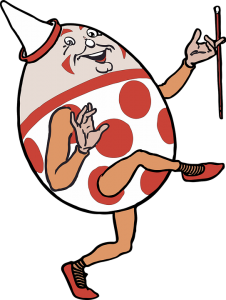
If you grew up somewhere in the United states I am sure you must know or have heard about Humpty Dumpty. This rhyme is described as one of the best rhymes in the history of English. Although Humpty Dumpty is described as personified eggs, he has nothing related with an egg. Surprisingly, even the lyrics of the rhyme do not mention an egg somewhere. Despite this, it has become a popular method to represent Humpty Dumpty with a symbol of an egg.
History of the rhyme
This is one of the oldest rhyme since the evolvement of English. The first version of the rhyme was published in 1791 with certain lyrics. Since then, the rhyme has had a lot of publishers with small adjustment such as Mother Goose’s Melody (1803) which had a slight different ending line. The second publication was made by Gammer Gurton’s Garland (1810). From there, James Orchard Halliwell published it in 1842. During that time Humpty Dumpty represented someone who is short and clumsy. Today, the rhyme is no longer used for riddles since almost everyone knows the answer. However, it may be used in a similar form and come out as a riddle.
Meaning of the rhyme
The key subject of the rhyme is not an egg since it was an answer to a riddle. As stated, the rhyme is no longer used as a riddle since almost everyone can shout what the answer is. However, there are theories which have been developed by certain people to give a deeper insight of the meaning. Scholars such as Katherine Elwes Thomas gave a meaning of the rhyme in 1930 saying that the rhyme represented King Richard III who was the then king of England who was defeated in a war despite his strong and large militia. Other individuals such as Professor David Daube in1956 wrote a new meaning of the rhyme was a tortoise which tried to approach the head of parliamentary in the city of Gloucester. In 1996 a website called Colchester stated that the rhyme represented a canon which was situated in the St. Mary’s church and was held by a royalist solder in the year 1643.
Places where the rhyme is used today
Today, humpty dumpty song has become popular mostly in nursery rhyme centers. This rhyme has been popularised through the various productions of animations, music and rhyme. Moreover, the rhyme is being used in literature to represent a short person, or something that would be very difficult to put together once damaged or someone in a very insecure position. The rhyme has been used widely in other literatures such as the ‘mother Goose in Prose’ where the character is devised by the king’s daughter. The rhyme has developed a meaning in science in the second law of thermodynamics.